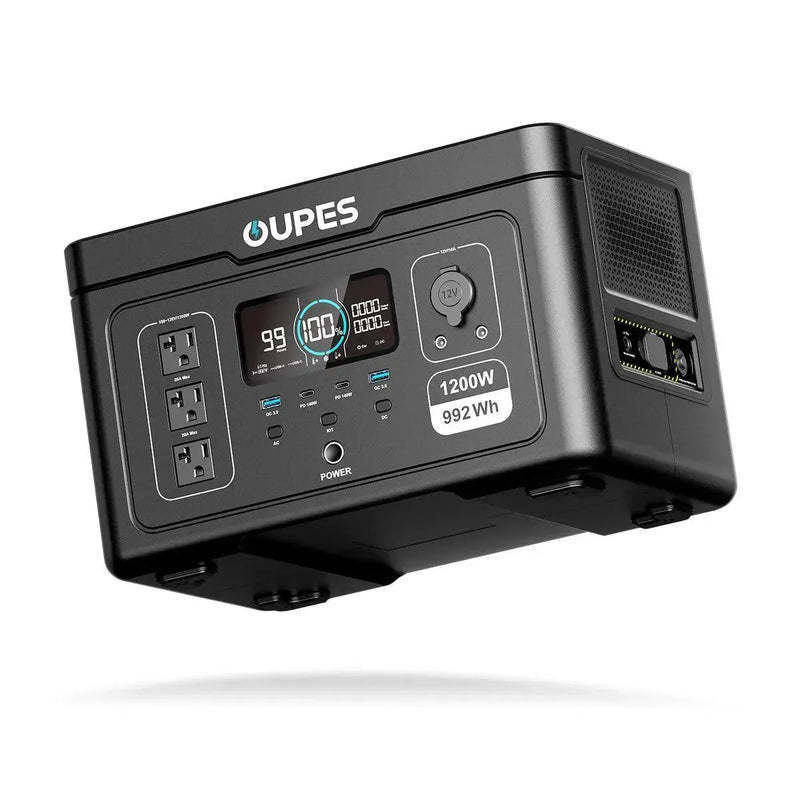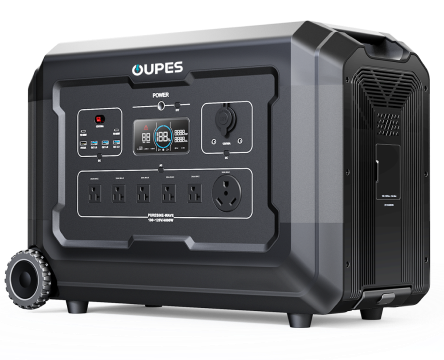
If you're thinking about going off-grid, prepping for an emergency, or simply want an eco-friendly way to power your mini fridge, a solar generator might be the perfect solution. Mini fridges are common in RVs, dorm rooms, offices, and camping setups, and their relatively low power consumption makes them ideal candidates for solar-powered systems. But what size solar generator do you actually need to keep your mini fridge running reliably? This article dives deep into the numbers, types of generators, and practical use cases to help you make an informed choice.
Understanding the Power Requirements of a Mini Fridge
The first step in choosing the right solar generator is understanding how much electricity your mini fridge consumes. Mini fridges typically consume between 50 to 100 watts during operation, though the exact number depends on factors such as size, insulation, age, and brand. It’s also important to consider the surge wattage—this is the extra burst of power required to start the compressor. The surge is typically 1.5 to 2 times the running wattage, so if your mini fridge runs at 70 watts, it might need 140 watts to start.
To find your fridge’s power requirements, check the manufacturer’s label, usually found on the back or inside door. It may list wattage directly or show amps and volts. If the label says 0.7 amps at 120 volts, multiply these two numbers to get the wattage: 0.7 x 120 = 84 watts.
It’s also critical to understand the duty cycle. A mini fridge doesn’t run constantly—it cycles on and off throughout the day. On average, it might run 8 to 12 hours per 24-hour period depending on ambient temperature and how often it’s opened. If your fridge uses 70 watts and runs for 10 hours daily, the total energy usage is about 700 watt-hours per day.
Knowing this daily energy requirement helps you select a solar generator with adequate battery capacity and input/output capabilities. A mismatch between the fridge’s needs and the generator’s output can lead to early shutdowns or limited usability.
Battery Capacity: Matching Daily Usage With Storage
Once you’ve calculated your mini fridge’s daily energy consumption, the next step is determining the battery capacity needed to support it. Battery capacity is typically measured in watt-hours (Wh), which indicates how much energy can be stored. To keep a fridge running through the night or during overcast days, you'll need a battery that holds at least as much energy as your fridge consumes in 24 hours.
Let’s say your mini fridge uses about 700Wh per day. In this case, your solar generator’s battery should have a minimum capacity of 700Wh just to cover one day. However, for practical use and to avoid draining the battery completely (which can reduce its lifespan), it's best to choose a battery with a larger capacity—around 1000Wh or more. This buffer also helps in case the fridge runs longer than expected due to high ambient temperatures or increased usage.
Lithium-ion batteries are the most common type used in solar generators. They are efficient, lightweight, and offer a longer lifespan compared to lead-acid alternatives. Additionally, some solar generators allow battery expansion, which is useful if you plan to add more appliances in the future.
If you're only using the solar generator intermittently—for example, during camping trips or occasional blackouts—you might get away with a smaller battery. But for daily or off-grid use, a larger battery bank ensures consistent performance. Always factor in not just your current energy demands, but potential future needs as well.
In summary, aim for a solar generator with at least 1000Wh of battery storage to run a typical mini fridge comfortably for a full day, allowing for efficiency losses and battery longevity.
Solar Panel Input and Charging Considerations
A solar generator’s battery needs to be recharged, and that’s where solar panels come in. The efficiency and wattage of your solar panels will determine how quickly you can recharge your system and whether you can maintain continuous use over multiple days.
If your mini fridge uses 700Wh daily and you want to fully replenish the battery each day, your solar panel array needs to generate at least that amount of energy—ideally more to account for inefficiencies and weather conditions. A 200-watt solar panel operating in optimal sunlight (about 5 full sun hours per day) can generate around 1000Wh daily. That would be sufficient to recharge a 1000Wh solar generator used to power a mini fridge.
However, real-world performance often falls short of lab conditions. Factors such as cloud cover, panel angle, time of year, and shading can reduce solar output. That’s why it’s a good idea to slightly oversize your solar input. Two 150-watt panels, for instance, can provide greater reliability than a single 200-watt panel. Many solar generators also allow chaining multiple panels together to speed up charging.
Solar input ports on generators have different limits, so check the maximum wattage input supported. A generator that only accepts 100 watts of solar input will take longer to charge than one with a 300-watt input capacity, even if the battery sizes are the same. Fast solar charging becomes especially important if you're using the fridge continuously in an off-grid setup.
To maximize performance, use high-quality monocrystalline panels, keep them clean, and orient them toward the sun. Consider a portable setup if you're using the solar generator for camping or mobile use, as foldable solar panels are lightweight and easy to transport.
Choosing the Right Solar Generator for Your Needs
With all these variables—power requirements, battery capacity, and solar input—it’s time to choose a solar generator that meets your needs. There’s a wide range of solar generators on the market, and picking the right one depends on how you plan to use your mini fridge.
For Light Use (Camping, Tailgating, Short Trips): If you only need to power your mini fridge for a few hours or a single day, a compact generator with a 500–700Wh battery might be sufficient. These units are lightweight, easy to carry, and charge quickly with a small solar panel. Just make sure the surge wattage rating can handle your fridge’s compressor startup.
For Full-Day Use (Home Backup, Extended Off-Grid Living): Look for a solar generator with at least 1000–1500Wh of battery capacity, and a continuous output of at least 300 watts. This ensures you can run the fridge throughout the day and recharge the battery in time for the next cycle. Models with high solar input ratings and expansion options are best for these use cases.
For Long-Term Power Solutions: If you're building a self-sustaining system for a cabin, van, or tiny home, consider a solar generator with modular battery expansion and MPPT charge controllers. These units offer the best long-term value and flexibility. Pair them with 300–400 watts of solar panels to ensure adequate energy generation year-round.
Whichever system you choose, always verify that the inverter can support continuous and surge power requirements. Also check the number and type of AC/DC ports, battery chemistry, and warranty terms to ensure a good fit for your lifestyle and usage habits.
Real-World Scenarios and Best Practices
Let’s look at how a properly sized solar generator performs in real-life situations, and what practices help optimize its usage. These examples provide practical insight into making the most of your investment.
Scenario 1: Weekend Camping Trip
A user brings a 600Wh solar generator and a 100W solar panel to power a 60-watt mini fridge for a two-day camping trip. With the fridge running about 8 hours per day (480Wh), the generator can handle it comfortably for one day. On the second day, the solar panel can replenish around 400–500Wh if there's good sun, just enough to keep the fridge going. The key to success here is moderate usage and optimal solar panel placement.
Scenario 2: Emergency Backup at Home
During a power outage, a family uses a 1200Wh solar generator with 200W of solar input to run their mini fridge, charge phones, and power a light. The fridge consumes 700Wh, leaving 500Wh for other devices. With decent sunlight, the solar panels restore 900–1000Wh daily, allowing the system to function indefinitely. Efficient load management and staggered device usage are crucial in this case.
Scenario 3: Full-Time Van Life
A van dweller runs a 12V mini fridge with a 1500Wh solar generator and 300W of monocrystalline panels. The fridge uses 60 watts intermittently, totaling about 600Wh per day. The solar panels reliably generate 900–1200Wh depending on weather. The extra energy powers lights, a fan, and a laptop. This setup offers independence and peace of mind, even on cloudy days, thanks to energy-efficient appliances and a properly sized system.
These scenarios show that a well-matched solar generator and fridge combo can handle a variety of needs. Success comes down to understanding your energy usage, maintaining the system, and planning for variability in solar generation.
Conclusion
Choosing the right size solar generator to run a mini fridge doesn’t have to be complicated. By understanding your fridge’s power consumption, factoring in daily usage cycles, selecting an appropriately sized battery, and ensuring you have sufficient solar panel input, you can create a reliable and efficient power setup.
Whether you're preparing for emergencies, embarking on a camping adventure, or building an off-grid lifestyle, a solar generator matched to your specific needs will give you the confidence to keep your food cool and your setup sustainable. Always plan ahead, aim for some extra capacity, and optimize for real-world conditions to get the best performance from your solar generator system.




























